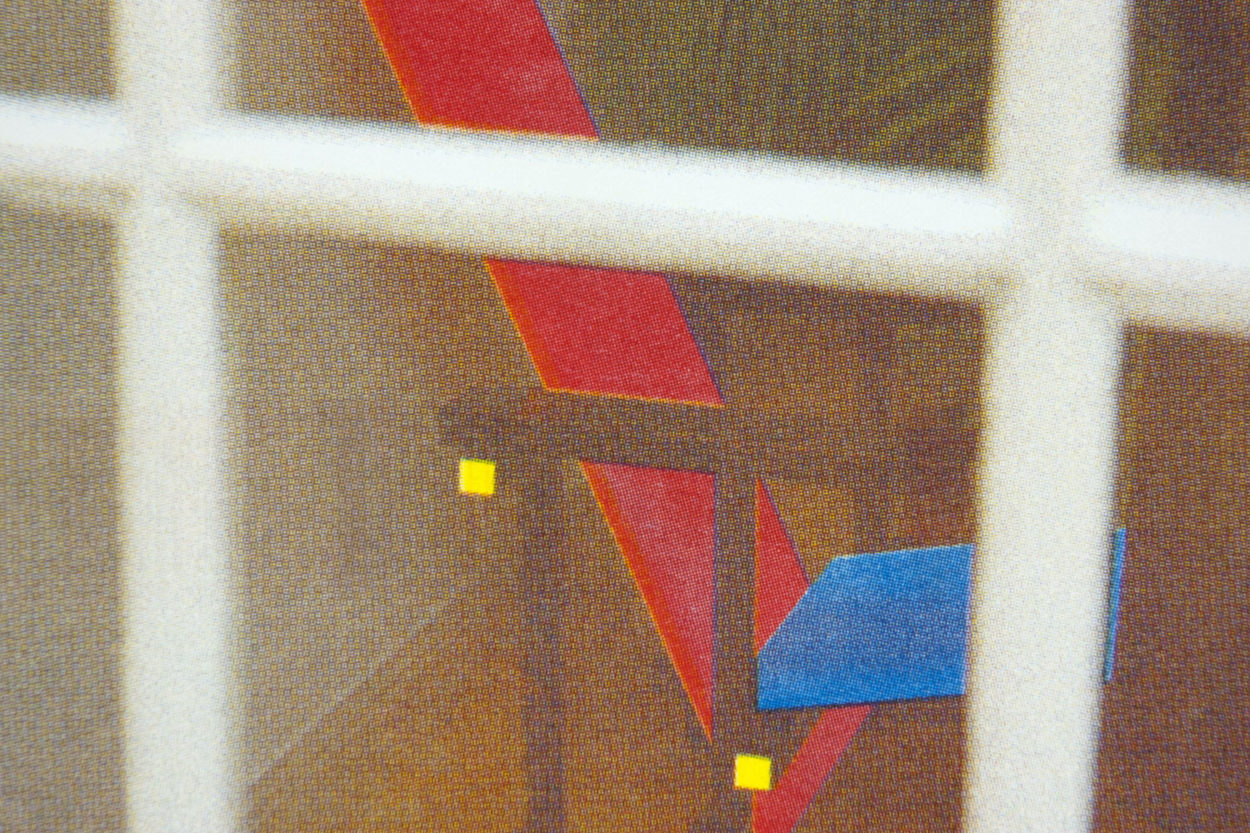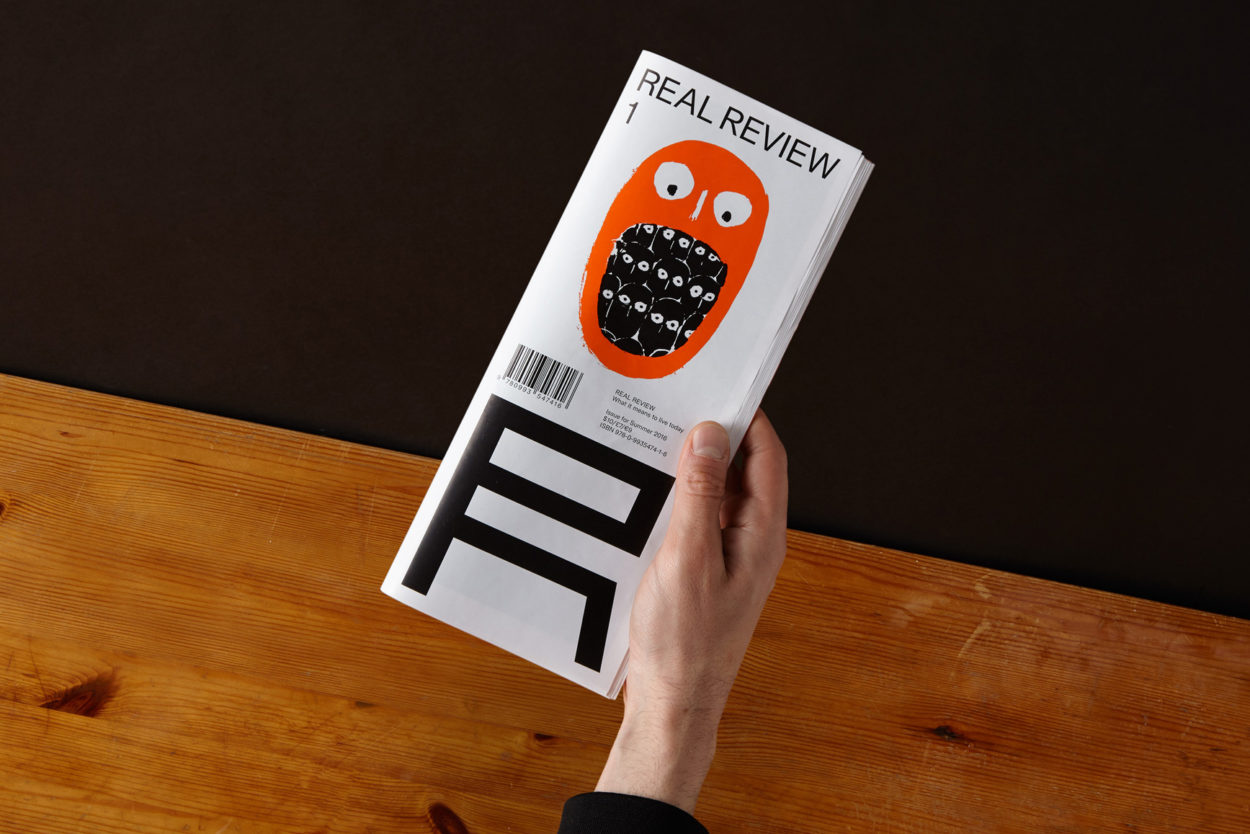Published
Toward a Common Practice—Chapter 3: Digression (or) A portrait of the artist as a young man
This chapter considers how digression might manifest in design practice; it briefly considers the historical role of design in society; it offers examples of designers exploring alternative modes of practice; it provides definitions of digression and association; and outlines how this might inform a positioning of practice – fields of interest, research methods, disciplines, process and organisation.

The Rietveld Chair, captured here in Red, Yellow, Blue is an exemplar of De Stijl aims – to create a universal visual language from asymmetrical planes of primary colour (1).
In the first half of the twentieth century the Constructivists, De Stijl and Bauhaus made attempts to improve everyday life through design. In the second half, the discipline became entwined with commerce – fostering the prevailing misconception that this is its sole function (2). Design as an economic service is, most often, consistent with the view of it being a problem-solving activity. Ana Paula Pais of Slow Research Lab takes a divergent position. She writes, ‘design(ing) entails locating, and challenging the conditions of our current realities while creating alternative conditions that allow for new realities to happen’ (3). Here, we see design defined as a problem-setting activity, one that questions existing power structures, rather than perpetuating them. Jack Self expands, ‘Kant says that ethics and aesthetics are one. When you make an aesthetic proposition, you’re also making a moral and an ethical proposition, and you’re expressing your ideas about the world through that form’ (4). How might a commercial practice be ethically responsible? And how might a research practice remain economically viable?
The problem is that the ideals promoted by society are not the same as the ideals by which is ruled: it teaches altruism, but depends on egoism, approves of social responsibility, but rewards financial self-interest, advances goals of critical autonomy and all-round personal development while endorsing the system that condemns the majority to long hours of dull and undemanding labour.
Cited by David Frayne (5)
There are a small number of designers asking these questions through their work. For example, under the name Untold Stories Ruben Pater draws from design and journalism to create visual narratives around geopolitical issues, subverting the established role of the designer as apolitical conduit. His specific methodology and field of interest developed through self-initiated research projects have also prompted commissions. Another example is Brave New Alps. Originally a collaboration between Bianca Elzenbaumer and Fabio Franz, the ‘eco-social’ design practice has expanded to nine members and explores beyond the client-designer framework. They combine design research methods with radical pedagogy, community economies and DIY making. Particularly relevant to the concerns of this research, Slow Research Lab position their enquiry as a direct response to accelerated culture. The late William Drenttel of Winterhouse Studios, Editions and Institute emphasises that slow design ‘isn’t just about designing or evolving slowly, but about creating artefacts and experiences that encourage thoughtfulness and deliberation’ (6). Drenttel’s viewpoint applies to all mentioned models, which are more appropriately situated in the field of ‘critical design’.
Associations by John Smith narrates Herbert Clark’s text ‘Word Associations and Linguistic Theory’ whilst simultaneously overlaying images as rebuses to create new associations (7).
In Dot Dot Dot Issue 2 Fabrizio Gilardino writes, ‘Graphic design should be portable, asymmetric, discordant, restless, incorporeal and intuitive’ (8). His proposition is striking. It sits in stark contrast to the banality of conventional descriptions of the discipline. The contextually unfamiliar use of these words prompt intriguing associations while their semantics propose digression, returning us to the literary strategies introduced in the previous chapter. To make an association is to ‘connect (someone or something) with something else in one’s mind’. Employed in John Smith’s Associations and Ryan Gander’s Loose Associations (9) this strategy evokes Umberto Eco’s notion of ‘the open work’ – relying on the multiplicity of meaning and audience participation. To digress is to ‘Leave the main subject temporarily in speech or writing’. It derives from the Latin digressus, ‘to go aside, depart’. Within this research, this idea has informed the positioning of practice – it’s field of interest, research methods, disciplines, processes and organisation – as a form of alternative engagement, departing from preconceived conventions.

This research enquiry is underpinned by an associative framework, creating connections between the realms of conflict outlined in the first chapter, with three modes of walking. Macfarlane perceives walking as ‘enabling sight and thought, rather than encouraging retreat and escape; paths as offering not only means of traversing space, but also ways of feeling, being and knowing’ (11). The notion of roaming poses an alternative mode of living for the colonised individual. Solnit writes, ‘Walking shares with making and working that crucial element of engagement of the body and the mind with the world, of knowing the world through the body and the body through the world’ (12). Here, the act of traversing offers a more balanced comprehension of labour than our production-oriented culture (refer to Lines Not Short, Not Straight, Crossing and Touching). She continues, ‘Walking is … the antithesis of owning. It postulates a mobile, empty-handed, shareable experience of the land’ (13). The act of trespassing promotes an egalitarian attitude toward common space.
In the above framework, the strategy of association shifts criticism to proposition, pointing toward Pais’ ‘new realities’. This approach is seen in the practice of Jack Self. Established by Self, The Real Foundation builds a focused discourse from research and commissioned work. The Real Review, a quarterly contemporary culture magazine, explores ‘What it means to live today’ through the material evidence of power relations in space (14). Commissioned work includes projects like Home Economics which was curated for the British Pavilion at the Venice Architecture Biennale and presents five new models for living (15). Here, research and commissions enforce and reinforce each other, building a focused discourse that spans both arms.

The potential reach of self-published research, like The Real Review, can open up opportunities for commissioned work (14).
A digressive practice suggests specific research methods. One that has been employed consistently throughout the course of this inquiry is writing. Self states, ‘the reason that I write is that I would like to know what I think about things’ (16). Writing as thinking is a simple, established idea but in the context of accelerated culture, writing toward an informed argument seems slow and requires commitment. Our time and attention is in demand, not to mention the suspicion held for activities without tangible productive ends. Early in her practice, Jessica Helfand set herself the task of writing one 1500-1800 word essay every two months, which seems fruitful yet attainable. Another digressive method is interviewing, which has been tested as an informal, walk-led conversation inspired by the ‘talks-walking’ of poets Robert Frost and Edward Thomas, Scratching the Surface and oral historian Studs Turkel.
Digression suggests specific disciplines. These might be ‘artefacts and experiences that encourage thoughtfulness and deliberation’ or projects that offer value beyond private profit (17). For example, Europa operate within the traditional client-designer framework, but their work brings explicit value to social, political and cultural realms. They develop publications, environments and public realm interventions, exhibitions, signage and identities for artists, architects, councils, curators, educators and publishers.

A digressive practice values particular processes. It sees design as being necessarily holistic, as opposed to the alienating division of labour. The latter occurs in many large agencies – as noneventuating pitch and/or conceptual work, or passed between freelancer and full-timer, designer and art-worker. ‘Holistic’ means that the designer(s) work(s) autonomously, except where guidance is necessary, from concept to production. The value placed on the final production calls for a ‘rematerialisation’ of design. The pleasure of making is intrinsic to the role of a designer and we are fortunate that our labour is directed toward the creation of tangible artefacts and experiences. A digressive practice acknowledges the life of the designed outcome, rather than just its birth. Pater asks, ‘What does a poster look like on the street? What happens if 2000 flyers get thrown out?’ (19). A designer’s impact isn’t relinquished when the invoice is paid and the full-screen image appears crisp on the landing gallery of their website. To neglect the life of a designed outcome is short-sighted and irresponsible.
A practice that digresses against accelerated culture takes a distinct organisational form. One concern is the distribution of its time. In conventional studios the distribution of time is dictated by externalities – clients, pitches, emails and deadlines. But what appears ‘client-focused’ is often counter-productive, resulting in long hours peppered with distracting emails. In contrast, a digressive practice sets stricts boundaries around time. This manifests as; an adherence to the 40 hour week distributed as flexible hours; emails addressed as if they were a calendar item and not a perpetual flow; and projects given 6-week timescales. The intended outcome of these confines is improved quality of work and well-being of workers. Another priority is the organisation of people. A digressive practice subverts the strict hierarchy of convention, employing instead an Employee Benefit Trust, as does Thomas Mathews, or a Cooperative model, like Inkahoots, to ensure that all workers are treated fairly and equally.
The positioning of a digressive practice can inform, and is not limited to – its fields of interest, research methods, disciplines, process and organisation. Within the context of ongoing research, it is intended that these propositions will be further defined and explored. Fundamentally, a digressive practice recognises that the value referred to in Cannon’s ‘worthwhile ethic’ is in its process and people (20).
•
Continue to the concluding statement
Notes
The chapter title A Portrait of the artist as a young man refers to the 1916 novel by James Joyce which traces the intellectual and religious awakening of its protagonist.
References
- Worth, R. (2015) Red Yellow Blue. Self-published.
- Rawsthorn, A. (2013) Hello World. London: Penguin Books.
- Pais, A. P. and Strauss, C. (2017) Slow Reader. Amsterdam: Valiz.
- Fuller, J. and Self, J. (2017) Scratching the Surface [Podcast]. 26 July. Available at: www.scratchingthesurface.fm/ post/163433522135/37-jackself (Accessed: 17 August 2017).
- Frayne, D. (2015) The Refusal of Work. London: Zed Books.
- Beirut, M., (2017) Design Observer. Available at: www.designobserver.com/feature/in-praise-of-slow-design/3947 (Accessed: 6 October 2017).
- Associations (1975) Directed by John Smith [Film].
- Bailey, S. and Bilak, P. [ed] (2001) Dot Dot Dot, Issue 2.
- Gander, R. (2007) Loose Associations and Other Lectures. Available at: www.onestarpress.com/book/ryan-gander-loose-associations-andother-lectures (Downloaded: 28 July 2017).
- Unknown photographer. (1967) ‘Sous les paves, le plage’.
- Macfarlane, R. (2016) Landmarks. London: Penguin Books.
- Solnit, R. (2014) Wanderlust: A History of Walking. London: Granta Books.
- Ibid
- The Real Review (2016-present) [Publication]
- Home Economics (2016) [Exhibition]. Venice. 28 May–27 November 2016.
- Fuller, J. and Self, J. (2017) Scratching the Surface [Podcast]. 26 July. Available at: www.scratchingthesurface.fm/ post/163433522135/37-jackself (Accessed: 17 August 2017).
- Beirut, M., (2017) Design Observer. Available at: www.designobserver.com/feature/in-praise-of-slow-design/3947 (Accessed: 6 October 2017).
- Europa (2019) Station Road Harrow. Available at: www.europaeuropa.co.uk/#id-unite-against-dividers (Accessed: 24 April 2019).
- Fuller, J. and Pater, R. (2017) Scratching the Surface [Podcast]. 15 February. Available at: www.scratchingthesurface.fm/post/157262525900/16-ruben-pater (Accessed: 14 November 2017).
- Frayne, D. (2015) The Refusal of Work. London, Zed Books